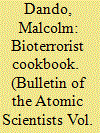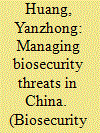| Srl | Item |
| 1 |
ID:
066367


|
|
|
| 2 |
ID:
089863


|
|
|
|
|
| Publication |
2009.
|
| Summary/Abstract |
The Biological and Toxin Weapons Convention (BTWC) is widely understood to be the weakest of the international arms control agreements prohibiting weapons of mass destruction as it lacks both an effective verification system and major international supporting organization. This article considers the statements made at BTWC meetings and comapares them to the current level of biosecurity education among life scientists.
|
|
|
|
|
|
|
|
|
|
|
|
|
|
|
|
| 3 |
ID:
103480


|
|
|
|
|
| Publication |
2011.
|
| Summary/Abstract |
Compared to the extensive literature on bioterrorism and biosecurity in the United States, less analysis has been conducted on similar challenges in China. This article seeks to fill this void by providing an integrated and updated assessment of 3 major biosecurity threats China faces: biowarfare, bioterrorism, and biocrimes. An analysis of China's biosecurity threats and biodefense building suggest varying levels of risk associated with each threat type. First, a direct bioweapons attack on China is highly unlikely, although the threat of biowarfare cannot be simply written off. Second, potential perpetrators of bioterrorism have capabilities at their disposal for carrying out such attacks. While terrorist organizations in China do not have a strong interest in bioterrorism, the limited state capability to counter such a threat may increase the risk in the future. Third, unlike the threats of biowarfare and bioterrorism, potential perpetrators of biocrimes have both incentives and capabilities, and biocrimes can produce reactions far out of proportion to the actual number of casualties. Despite the distinct biosecurity challenges it faces, China has yet to articulate a differentiated and coherent strategy to effectively tackle the challenges. Assessing different types of biosecurity threats in terms of degrees of risk not only provides greater analytical clarity but also has important implications for the strategies required to manage the risks.
|
|
|
|
|
|
|
|
|
|
|
|
|
|
|
|